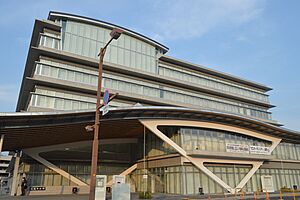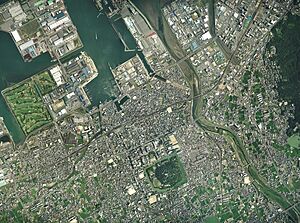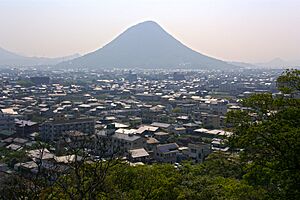Marugame, Kagawa facts for kids
Quick facts for kids
Marugame
丸亀市
|
|||||||||||
|---|---|---|---|---|---|---|---|---|---|---|---|
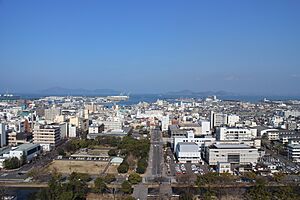
View of downtown Marugame City, from Marugame Castle
|
|||||||||||
|
|||||||||||
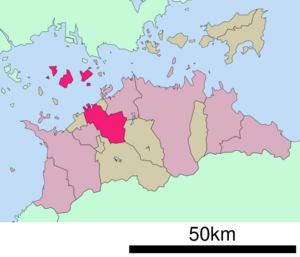 |
|||||||||||
| Country | Japan | ||||||||||
| Region | Shikoku | ||||||||||
| Prefecture | Kagawa | ||||||||||
| Area | |||||||||||
| • Total | 111.79 km2 (43.16 sq mi) | ||||||||||
| Population
(October 1, 2022)
|
|||||||||||
| • Total | 108,541 | ||||||||||
| • Density | 970.94/km2 (2,514.71/sq mi) | ||||||||||
| Time zone | UTC+09:00 (JST) | ||||||||||
| City hall address | 2-3-1 Ōtemachi, Marugame-shi, Kagawa-ken 763-8501 | ||||||||||
|
|||||||||||
Marugame (丸亀市, Marugame-shi) is a city in Kagawa Prefecture, Japan. As of October 1, 2022, about 108,541 people lived there. The city covers an area of 111.79 square kilometers (43.16 sq mi).
Contents
Geography of Marugame
Marugame is in the northern part of Kagawa Prefecture. It is on the island of Shikoku, facing the Seto Inland Sea to the north. The city includes parts of the Marugame Plain and some of the Shiwaku Islands.
Like many places in Kagawa, Marugame has many water reservoirs. The Doki River flows through the city from north to south. To the south, you can see Mount Tsutsumi, also known as Hatoko Fuji. Another famous mountain, Mount Iino, is nicknamed Sanuki Fuji. It sits on the border between Marugame and Sakaide. Both are part of the "Sanuki Seven Fujis."
Nearby Cities and Towns
Marugame shares borders with several other places in Kagawa Prefecture:
- Ayagawa
- Mannō
- Sakaide
- Tadotsu
- Utazu
- Zentsūji
Climate in Marugame
Marugame has a humid subtropical climate. This means it has warm summers and cool winters. There is usually light snowfall in winter. The average temperature in Marugame is about 15.7 °C (60.3 °F). The city gets about 1439 mm (56.7 in) of rain each year. September is usually the wettest month. August is the warmest month, with temperatures around 26.6 °C (79.9 °F). January is the coldest, at about 5.3 °C (41.5 °F).
Population Changes
The number of people living in Marugame has grown for many decades. Recently, the population has stayed about the same.
| Historical population | ||
|---|---|---|
| Year | Pop. | ±% |
| 1950 | 87,271 | — |
| 1960 | 81,523 | −6.6% |
| 1970 | 78,263 | −4.0% |
| 1980 | 94,849 | +21.2% |
| 1990 | 101,253 | +6.8% |
| 2000 | 108,356 | +7.0% |
| 2010 | 110,473 | +2.0% |
| 2020 | 109,513 | −0.9% |
History of Marugame
The area where Marugame is located has been lived in for a very long time. Many ancient kofun (burial mounds) have been found here.
During the Heian period (794-1185), Marugame became a popular stop for people traveling to the Kotohira-gū shrine. Later, in the Edo Period (1603-1868), it grew into a jōkamachi (castle town) around Marugame Castle. The Kyōgoku clan ruled this area for 210 years.
After the Meiji restoration in 1868, Marugame officially became a town on February 15, 1890. It became a city on April 1, 1890. This made it the 53rd city in Japan. In the 1950s, some nearby areas and islands joined Marugame.
On March 22, 2005, the towns of Ayauta and Hanzan merged with Marugame. This made the city of Marugame even larger.
Economy and Industry
Marugame has a mixed economy. This means it has different types of businesses.
- Agriculture: Farmers grow rice, vegetables, and peaches. They also raise chickens.
- Manufacturing: Along the coast, there are many factories and shipyards. They make things like textiles (cloth) and build ships.
Marugame is also famous for making uchiwa fans. These are traditional Japanese fans. In the past, Marugame made 90% of all uchiwa fans in Japan. Today, fewer workshops make them by hand.
Because Marugame has good transportation, more industries are growing there. Many people who work in the nearby city of Takamatsu live in Marugame.
In 2015, a company called Imabari Shipbuilding announced they would build a huge dry dock in Marugame. This dock can build very large container ships.
Education in Marugame
Marugame has many schools for young people.
- The city government runs 18 public elementary schools and eight public middle schools.
- The Kagawa Prefectural Board of Education runs four public high schools.
- There is also one private middle school and two private high schools.
- Two high schools offer correspondence courses, which means students can learn from home.
Transportation
Marugame has good ways to get around, both by train and by road.
Railways
- Kurikuma
- Okada
![]() Takamatsu-Kotohira Electric Railroad - Kotohira Line
Takamatsu-Kotohira Electric Railroad - Kotohira Line
- Marugame
- Sanuki-Shioya
Highways
 Takamatsu Expressway
Takamatsu Expressway National Route 11
National Route 11 National Route 32
National Route 32 National Route 319
National Route 319 National Route 377
National Route 377 National Route 438
National Route 438
Sister Cities
Marugame has special friendships with cities in other countries. These are called sister cities.
 Donostia / San Sebastián, Spain (since 1990)
Donostia / San Sebastián, Spain (since 1990) Pasig, Philippines
Pasig, Philippines Willich, Germany (since 2023)
Willich, Germany (since 2023) Zhangjiagang, Jiangsu, China (friendship city since 1990)
Zhangjiagang, Jiangsu, China (friendship city since 1990)
Fun Places to Visit
Marugame has many interesting places to see and things to do.
- Kaitenyama Kofun: This is an ancient burial mound and a National Historic Site.
- Marugame Castle: This is one of only 12 Japanese castles that still have their original wooden main tower (keep). It is also a National Historic Site.
- Marugame Genichiro-Inokuma Museum of Contemporary Art (MIMOCA): This museum is near the railway station. It shows the artworks of Genichiro Inokuma and also has special exhibitions.
- Reoma World: This is a fun place with many rides, attractions, restaurants, a spa, and a hotel.
- Shiwaku Kinbansho: This is another National Historic Site.
Events in Marugame
- Marugame Half Marathon: This big running race happens every year in early February. Thousands of runners take part. It has been held since 1947. In 2006, a new Asian record for the half marathon was set on this course by Kayoko Fukushi.
Famous People from Marugame
Some well-known people were born or grew up in Marugame:
- Yoshihiko Isozaki: A politician.
- Katsuyuki Motohiro: A movie director.
- Fumiko Saiga: A judge who worked at the International Criminal Court.
- Toshio Yamauchi: A politician.
See also
 In Spanish: Marugame para niños
In Spanish: Marugame para niños





